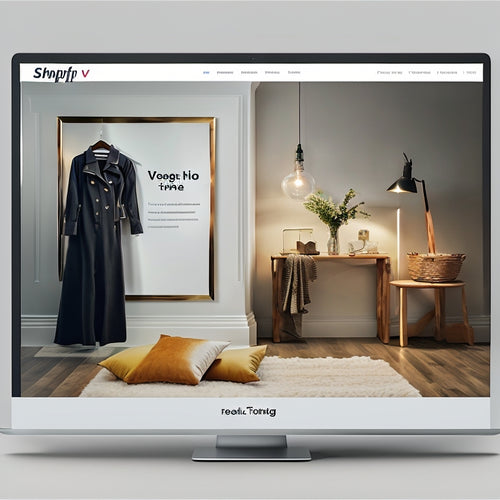
Boost Online Course Revenue With Proven Pricing Strategies
Share
You can boost online course revenue by up to 30% by implementing a data-driven pricing strategy. Identify your ideal learner and analyze the market to create a competitive offer. Tiered pricing and strategic discounts can increase revenue by 20-30%. Leverage psychological pricing tactics, such as anchoring effects and scarcity, to influence buyer behavior. Value-based pricing strategies can help you assign a price that reflects the course's unique benefits. By adjusting prices in real-time and optimizing for scalability, you can balance revenue growth with customer demand. Now, get ready to maximize your online course revenue with proven pricing strategies that drive results.
Key Takeaways
• Tiered pricing strategies can increase revenue by 20-30% by influencing buyer behavior and creating a sense of urgency.
• Understanding the target audience and market analysis helps identify ideal learners, pain points, and preferences to inform pricing decisions.
• Value-based pricing strategies assign prices based on unique benefits and results, correlating price with course value and student willingness to pay.
• Dynamic pricing and scalability allow for real-time price adjustments to reflect market conditions, influencing buyer behavior and optimizing revenue growth.
• Leveraging psychological pricing tactics, such as anchoring effects and scarcity, can drive sales and revenue by exploiting consumer psychological triggers.
Understanding Your Target Audience
As you develop your online course, identifying your ideal learner is vital, since it directly impacts the pricing strategy that will resonate with them and ultimately drive revenue. To create a profitable online course, you need to understand who your students are, what they want to achieve, and what motivates them.
This is where student personas come in. By creating detailed profiles of your ideal learners, you can tailor your engagement strategies to meet their needs, increasing the chances of successful outcomes and, consequently, driving revenue.
Conducting market research is essential in understanding your target audience. It helps you gather data on their pain points, preferences, and behaviors, enabling you to design a pricing strategy that resonates with them. Pricing experiments can also provide valuable insights into how your students respond to different pricing tiers and models.
Competitor Price Analysis Matters
You can gain a significant edge in the online course market by analyzing your competitors' pricing strategies. This can reveal gaps in the market and opportunities to differentiate your course.
By conducting market research, you'll uncover what your competitors are charging for similar courses, and identify areas where you can improve or innovate. This analysis will help you develop pricing strategies that position your course as a premium offering or a more affordable alternative.
When analyzing your competitors' pricing, look for patterns, such as discounts, bundles, or tiered pricing. Identify what's working for them and what's not. You'll likely find that some competitors are undercharging or overcharging for their courses, creating opportunities for you to fill the gap.
Use this data to inform your pricing decisions, and adjust your strategy accordingly. By understanding your competitors' pricing, you'll be able to create a more competitive and attractive offer that resonates with your target audience. This will ultimately drive more sales and revenue for your online course.
Tiered Pricing for Maximum Revenue
When you implement tiered pricing, you're not just offering different versions of your online course - you're creating a strategic pricing structure that influences buyer behavior.
By using price anchors, you can make your mid-tier option look like a steal, increasing the likelihood that customers will opt for it over the basic or premium versions.
Price Anchors Matter
Tiered pricing, a strategy rooted in the concept of price anchors, has been shown to increase online course revenue by up to 25% by cleverly manipulating customers' perceived value.
By offering multiple versions of your course at different price points, you create anchoring strategies that influence how customers perceive the value of each option. This pricing psychology hack works because customers tend to base their purchasing decisions on relative value rather than absolute prices.
When you offer a premium version of your course at a higher price, it creates a price anchor that makes the middle-tier option seem more affordable by comparison. This increases the chances of customers opting for the middle tier, which is often the sweet spot for maximum revenue.
Segmenting for Profit
By segmenting your audience into distinct groups based on their needs and preferences, you can create multiple versions of your course that cater to each segment, thereby maximizing revenue through strategic tiered pricing. This pricing segmentation strategy allows you to tap into the willingness of each group to pay, resulting in profit maximization.
For instance, you can offer a basic version of your course at a lower price point for students who only need the fundamentals, while offering a premium version with advanced features and personalized support at a higher price point for those who are willing to invest more. By doing so, you're able to capture a wider range of your target audience, increasing overall revenue.
Data shows that tiered pricing can lead to a 20-30% increase in revenue compared to a one-size-fits-all approach. By understanding your target audience's needs and preferences, you can develop pricing strategies that resonate with each group, driving revenue and growth.
Discounts and Limited-Time Offers
You're likely no stranger to the allure of limited-time deals, and your online course customers are no exception. By strategically offering discounts and limited-time promotions, you can create a sense of urgency that drives sales and boosts revenue.
Let's explore three approaches to discounts and limited-time offers that have proven to deliver results:
flash sale frenzy, exclusivity drives demand, and scarcity boosts sales.
Flash Sale Frenzy
Limited-time offers and discounts can catapult your online course sales by up to 25%, making them a potent revenue-boosting strategy in your pricing arsenal. By leveraging flash sale tactics, you can create a sense of urgency that drives sales and increases revenue.
Here are three ways to maximize the impact of your flash sales:
-
Create scarcity: Use limited-time offers to create a sense of FOMO (fear of missing out) among potential customers. This pricing psychology tactic taps into customers' emotional desire to avoid missing out on a great deal.
-
Offer exclusive deals: Provide exclusive discounts to specific groups, such as early bird registrations or loyalty program members. This creates a sense of belonging and increases the perceived value of your course.
-
Use countdown timers: Display countdown timers on your website or social media channels to create a sense of urgency and encourage immediate purchases. This visual cue amplifies the psychological impact of your flash sale.
Exclusivity Drives Demand
Within 24 hours of launching an exclusive offer, you can expect a significant surge in online course sales, with some marketers reporting a staggering 40% increase in revenue. This is because exclusivity drives demand.
When you offer exclusive benefits to a select group, they feel valued and privileged, leading to a sense of urgency to take advantage of the opportunity. Limited-time offers create a sense of FOMO (fear of missing out), which can be a powerful motivator for potential customers.
By offering exclusive benefits, you're not only creating a sense of scarcity but also making your customers feel like they're part of an elite group. This can lead to high demand, as people are willing to pay a premium for exclusive access.
To maximize the impact, make sure to clearly communicate the exclusive benefits and the limited-time nature of the offer. This will create a sense of excitement and drive sales. By leveraging exclusivity, you can boost your online course revenue and establish yourself as a premium brand.
Scarcity Boosts Sales
By incorporating discounts and limited-time offers into your online course pricing strategy, you can tap into the psychological power of scarcity, driving a significant increase in sales and revenue. This tactic works because it creates a sense of urgency, prompting potential customers to make a purchase before the offer expires.
By leveraging psychological triggers like FOMO (fear of missing out), you can motivate buyers to take action sooner rather than later.
Here are three ways to implement discounts and limited-time offers effectively:
-
Limited-time discounts: Offer a percentage off your course for a specific period, creating a sense of urgency among potential customers.
-
Exclusive bundles: Package your course with complementary resources or services, available only for a limited time, to create a sense of scarcity.
-
Countdown promotions: Create a countdown timer on your sales page, displaying the limited time remaining to purchase your course at a discounted rate, thereby creating a sense of FOMO.
The Power of Anchoring Effect
When you strategically place a higher-priced option next to a lower-priced one, you exploit the anchoring effect, a psychological phenomenon that influences customers to perceive the lower price as more reasonable and increase their willingness to pay. This pricing psychology tactic is rooted in consumer behavior, where people tend to rely on the first piece of information they receive (the anchor) to make subsequent judgments. By presenting a more expensive option, you create a reference point that makes the lower-priced option seem more affordable by comparison.
Here are some examples of anchoring effect in action:
| Option | Price |
|---|---|
| Basic Course | $299 |
| Premium Course | $499 |
| Basic Course | $199 |
| Pro Course | $399 |
| Starter Package | $99 |
| Advanced Package | $299 |
Price Psychology in Action
You leverage the anchoring effect to influence purchasing decisions, but that's just the tip of the iceberg - there are more price psychology tactics to explore. By understanding how pricing psychology works, you can optimize your online course revenue and outperform your competition.
Here are three ways to put pricing psychology into action:
-
Use price endings strategically: Prices ending in .99 or .97 can create a psychological perception of value, making your course seem more affordable. On the other hand, prices ending in .00 can convey a sense of premium quality.
-
Employ the scarcity effect: Create a sense of urgency by offering limited-time discounts or promotions. This can motivate potential customers to make a purchase decision quickly, driving up revenue.
-
Make use of price relativity: Position your course as a premium offering by comparing it to higher-priced alternatives. This can make your course seem like a more affordable and attractive option, boosting sales and revenue.
Value-Based Pricing Strategies
Value-based pricing strategies help you assign a price tag to your online course that directly correlates with the unique benefits and results it delivers to students, allowing you to charge a premium and maximize revenue. By understanding your customer personas and their willingness to pay, you can create a pricing strategy that resonates with them. This approach takes into account the value your course provides, such as increased earning potential, improved skills, or enhanced career prospects.
Here are some value-based pricing strategies to contemplate:
| Pricing Strategy | Description | Example |
|---|---|---|
| Results-based pricing | Charge based on the results students achieve | $1,000 for a course that guarantees a 20% increase in sales |
| Value metric pricing | Charge based on the value metric most relevant to students | $500 for a course that teaches how to create a successful online business |
| Tiered pricing | Offer different tiers of access to your course, each with varying levels of value | $200 for basic access, $500 for premium access, and $1,000 for VIP access |
| Bundling | Package multiple courses or services together to increase overall value | $2,000 for a bundle of 5 courses on entrepreneurship |
Dynamic Pricing for Online Courses
By optimizing your pricing strategy to respond to shifting market conditions, you can maximize revenue and stay ahead of the competition with dynamic pricing for online courses. This approach involves adjusting your prices in real-time to reflect changes in demand, supply, and consumer behavior.
By doing so, you can take advantage of pricing psychology to influence buyer behavior and drive revenue optimization.
Here are three ways to implement dynamic pricing for online courses:
-
Surge pricing: Increase prices during peak demand periods, such as when a new course is launched or during a popular promotion.
-
Discount pricing: Offer limited-time discounts to stimulate sales during slow periods or to clear out old inventory.
-
Tiered pricing: Offer different pricing tiers based on the level of access or features provided, allowing customers to choose the option that best fits their needs and budget.
Optimizing Pricing for Scalability
To achieve scalability and maximize revenue, your pricing strategy must be optimized to accommodate growing demand and evolving customer needs. As your online course gains traction, revisiting your pricing structure is crucial to align it with your business goals. By applying pricing psychology principles, you can create a pricing strategy that drives revenue optimization.
Analyze your customer segments and identify opportunities to tier your pricing. This could involve offering different levels of access, premium features, or exclusive content. Consider value-based pricing, where the price is directly linked to the value your course provides. This approach can help you capture more revenue from high-demand customers.
To further enhance your pricing, use data-driven insights to identify price elasticity and adjust your pricing accordingly. By doing so, you'll be able to find the optimal point that balances revenue growth with customer demand.
Frequently Asked Questions
How Often Should I Adjust My Online Course Pricing Strategy?
You shouldn't adjust your online course pricing strategy too frequently, aiming for pricing consistency. Instead, regularly gather customer feedback, monitor market trends, and conduct competitive analysis to inform strategic, data-driven price adjustments that drive revenue growth.
Can I Use Tiered Pricing for Low-Cost Online Courses?
You wonder if tiered pricing works for low-cost online courses. Research suggests it does, especially when you offer bundling options or subscription models, allowing customers to upgrade and increasing average order value. Try it!
Do Discounts Hurt or Help Online Course Revenue in the Long Run?
You'll find that strategic discounts can boost short-term sales, but may hurt revenue in the long run; instead, focus on pricing stability to drive sustainable growth and maximize revenue potential.
Is Value-Based Pricing Suitable for All Types of Online Courses?
As you navigate the pricing puzzle, you're wondering if value-based pricing is the holy grail for all online courses. But, you'll need to conduct a thorough cost analysis and market research to determine if it's the perfect fit for your unique offering.
Can I Use Dynamic Pricing for Evergreen Online Courses?
You can leverage dynamic pricing for evergreen online courses by offering time-sensitive promotions, creating customized bundles, and adjusting prices based on demand to maximize revenue and stay competitive.
Related Posts
-

Does Pinterest Integrate With Shopify
This article examines the integration of Pinterest with the e-commerce platform Shopify. It aims to provide an objec...
-

How Do You Optimize for Speed in Shopify Stores
Speed optimization is a crucial aspect to consider in Shopify stores, as it offers numerous benefits. This article a...
-

Maximizing Pinterest for Business Success
Pinterest has emerged as a valuable platform for businesses seeking to enhance their success. Boasting a substantial...


